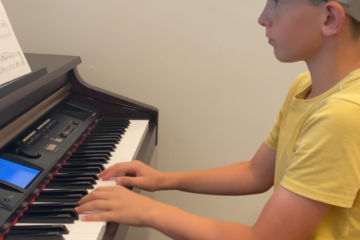I can almost hear the sounds that the boys in this photo were probably hearing when it was taken: the gentle lapping of the water, the movement of the pine trees, possibly some birds, probably some bugs.
Music and nature are intrinsically linked. Music exists in nature, and nature exists in music. It is not possible to separate the two. The argument could be made, in fact, that music is simply an imitation of the natural sounds around us.
Think of the rhythmic sound of ocean waves crashing and rolling. The vocalization of a songbird. The whisper of the wind through the aspen trees. The sound of trickling water, the chirping of a cricket, or the lapping of waves against the dock. These are all musical sounds.
Music from the Baroque period is often polyphonic – two or more melodies intertwining with each other. When I am sitting at my favorite picnic site in my favorite canyon, I can close my eyes and hear a myriad of beautiful melodies of nature intertwining with each other. I hear the rushing of the mountain stream, splashing over rocks and gurgling past me. I hear the wind whistling through the aspen trees. I hear birds of many varieties singing their unique songs. I hear chipmunks chittering and scrambling through the trees. I hear my campfire crackling and snapping. These very different sounds combine and interplay to create one complete, full, immersive experience.
The sounds of nature are also mimicked in other types of music. Jazz music comes to mind. Jazz music has a very conversational quality, a question-and-answer, call-and-response element. To me, this is reminiscent of the natural give-and-take, conversational tones that exist in the wild. For example, the sounds of birds or dolphins or other creatures “talking” and responding to each other. They call and respond. They give and take. They converse. Nature is immersed in its own conversation and communication. We are reproducing this in our own style when we create jazz music.
Pythagoras believed that celestial bodies and stars produce a noise as they whirl around. The tones vary according to the distance of each from the center, or Sun. The sum of those tones is the music of the spheres. We do not hear this heavenly symphony because we are accustomed to hearing the music as background, and our senses are not attuned to it.
There’s not the smallest orb which thou behold’st
But in his motion like an angel sings.
Kepler’s book, Harmonies of the World, tries to show that each planet possesses a distinctive voice range — bass, tenor, contralto and so on — and that the music it emits is determined by its distance from the common center of revolution, the sun, as the length of a string on an instrument determines its sound. John Wilkins in 16th century England believed that if we could hear the music of the spheres we could live by ‘feeding on the ear only.’ For this very reason, he says, Moses was able to tarry forty days and nights in the Mount without eating anything, because he there heard the melody of the heavens.
That’s a beautiful thought. I am determined to listen to more attentively to the music around me in nature.
(My thanks to Peter Rawlins for his contribution to this post.)



0 Comments